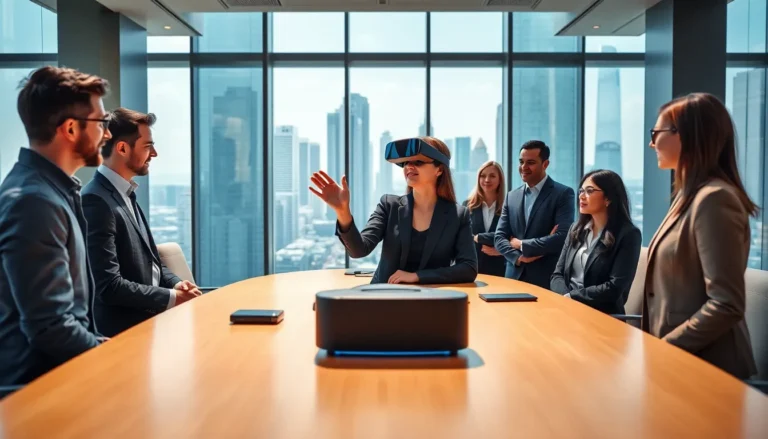Picture this: you’re walking down the street, and suddenly a dinosaur appears right in front of you, thanks to your smartphone. Welcome to the whimsical world of augmented reality (AR), where marketing is not just confined to the pages of your favorite magazine or the screens of your television. Companies are taking a giant leap beyond traditional methods to engage consumers in ways that are as entertaining as they are effective. If you’ve ever wondered how to make your marketing strategy stand out like a flamingo in a flock of pigeons, jump into the immersive universe of augmented reality campaigns.
Table of Contents
ToggleUnderstanding Augmented Reality

Augmented reality is a technology that blends digital information with the real world. Unlike virtual reality, which creates a completely immersive experience, AR overlays digital elements onto the physical environment. Think of it as an interactive layer of information added to your everyday life. By using smartphones, tablets, or specialized AR glasses, consumers can see and interact with 3D models, animations, and other digital content in real time. So, when a brand opts to integrate AR into its campaigns, they aren’t just selling a product: they’re creating an experience. This immersive interaction allows consumers to visualize products in their own environments, leading to increased engagement and a deeper emotional connection with the brand.
Benefits of Augmented Reality in Marketing
The benefits of augmented reality in marketing are as exciting as watching a magician pull a rabbit out of a hat. For starters, AR campaigns enhance customer engagement. When consumers can interact with a product and see it in their own space, their interest level skyrockets. Another significant benefit lies in how AR can improve information retention. Interactive experiences lead to better understanding and recall of brand messages, making it easier for consumers to remember that one furniture store with the awesome AR app they tried last time. Also, AR can serve as a differentiator in a crowded market. Brands using AR are seen as innovators, which can enhance overall perception and customer loyalty. Let’s not forget the shareability factor: when an AR experience gets people talking and posting on social media, that’s marketing gold.
Successful Augmented Reality Campaigns
Several brands have successfully harnessed the power of augmented reality in their marketing strategies, setting benchmarks for others to follow. One standout example is IKEA’s Place app, which allows customers to visualize furniture in their own rooms before purchase. Users can see how a couch would fit in their living room or whether that quirky lamp would match the décor. Another impressive campaign came from Disney, which transformed its Star Wars franchise with an AR app that let fans see characters from the movie in their surroundings. Engaging, entertaining, and effective, Disney’s strategy increased fan interaction significantly. Then there’s Pepsi, which used AR to create a jaw-dropping experience at a bus stop in London. Commuters were treated to whimsical animations that made them feel like they were part of a fantastic world, a little distraction from the drudgery of waiting. These successful campaigns illustrate how brands can create extraordinary experiences that resonate with audiences.
Key Components of a Successful AR Campaign
Creating a successful AR campaign is not simply about jumping on the latest tech trend. It requires careful planning and execution. First, clearly defined objectives are essential. What does the brand hope to achieve through the AR experience? Whether it’s driving sales, increasing brand awareness, or building customer loyalty, knowing this will shape the campaign’s direction. Second, understanding the target audience is paramount. Customizing the AR experience to meet their preferences and behaviors ensures higher engagement. The third component is content. AR content should be visually appealing, relevant, and entertaining, ensuring users have a memorable experience. Finally, ease of use matters. A complicated app can deter potential users and detract from the experience. The goal is to create a seamless interaction with technology that feels like a natural extension of the consumer’s everyday life.
Challenges and Considerations
Even though its numerous benefits, augmented reality presents several challenges and considerations that marketers must navigate. First, there’s the technological barrier. Not everyone has access to AR-capable devices, which can limit campaign reach. Brands need to consider their audience’s tech-savviness and potentially offer alternative ways to engage. Ensuring app functionality is another hurdle. AR applications require robust technical support and regular updates to provide a smooth user experience. Privacy issues present a significant concern as well. Marketers must handle user data sensitively and transparently to maintain trust. Also, marketers need to stay ahead of the rapidly evolving AR landscape. What’s cutting-edge today may become obsolete tomorrow, making continuous innovation essential.
The Future of Augmented Reality in Marketing
As technology continues to advance, the future of augmented reality in marketing looks incredibly promising. Experts predict an increase in the use of AR in e-commerce, where consumers can virtually try on clothes, cosmetics, or even jewelry. The rise of location-based AR experiences will likely create even more opportunities for brands to engage with consumers in real time. Imagine walking through a mall and receiving tailored offers on your phone, now, that’s personalized marketing. Also, brands might leverage AR for immersive storytelling, blending narrative with interactive experiences to captivate consumers profoundly. Businesses that adopt AR early will position themselves as forward-thinking leaders, creating richer customer interactions and setting themselves apart from the competition.






